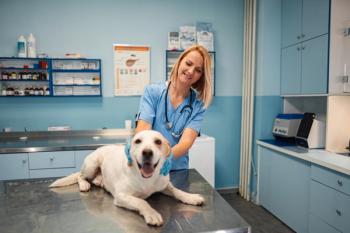
Why weight? Tackle pets' muffin tops and garbage guts
Use these 5 steps to build an effective pet weight-loss program at your veterinary hospital.
"Don't use the "F" word around Buster. He's sensitive." (Photo: Getty Images)F-A-T.
Shhhh! Don't say it out loud.
Mrs. Smith might hear you. And she might think you're talking about her-or worse, her darling Dexter, who couldn't be an ounce over his recommended weight. 'Cause, you know, he only gets treats at bedtime. And one at breakfast. Or when he's a really, really good dog. Which is all the time, because who could resist that adorable little face … and … well, you see the problem.
Talking pet weight loss is just plain tough. Clients may feel embarrassed and worried when you say their pets are overweight. It can feel overwhelming when you say their pets must lose weight. And some will get defensive or just plain deny their pet's muffin top or garbage gut. Sorry, Mrs. Smith, Fluffy's not just fluffy. And Parker's just plain portly. But you can't say it that way. (Need help framing your weight discussions with pet owners? Check out the mini-sized
Instead, try to take some of the stress out of these situations with a fun and effective weight loss program that engages clients and team members.
Step 1: Talk to your boss
Heavy resistance
Did you face some managers' reservations? Don't give up. Discuss how you could overcome those reservations, brainstorm some solutions and come back with a plan.
If your practice already has a weight-loss program in place, ask to revamp it and involve the whole team. Now off to Step 2!
Step 2: Train the team
Get 'em to pull their own weight!
If your veterinarians recommend a special therapeutic diet sold primarily or exclusively in veterinary practices, why not reach out to a rep from that company to arrange a “lunch and learn” meeting to explain how that food addresses obesity in your patients?
Before you start a new weight-loss program, make sure everyone on staff fully understands obesity in pets. Set a date to hold a CE meeting for the whole staff about pet obesity and weight loss. Educate team members from every department on:
> Risks associated with obesity in cats and dogs, such as diabetes mellitus, osteoarthritis, heart disease and hypertension
> Body condition scores (BCS), how to tell whether a pet is obese and how to show pet owners what to look for
> Pet weight-loss tips from your practice's veterinarians (special therapeutic diets, low-calorie treats, general exercise tips)
> Team members' roles when it comes to client education and assistance
> Tips for talking to pet owners about the sensitive issue of pet weight loss.
You may delegate all or part of this fat-focused meeting to a veterinarian or technician, or you may opt for an outside speaker.
Pile on! Building a weight-loss plan at your veterinary hospital is a team effort! (Photo: Getty Images)Step 3: Build a committee
Hey, you didn't think you'd need to do this all by yourself, did you? This meeting was to educate and fire up folks and get them excited to help. As your CE meeting wraps up, ask for volunteers to help develop the practice's new weight loss program.
Ideally, your committee will include at least one team member from each department (veterinarian, receptionist, technician, kennel and so on). Set a date for the committee to meet and begin developing the program. Ask everyone to bring ideas. Come with your own ideas as well. (You didn't think you were totally off the hook, did you?)
Step 4: Develop the program
What's your role?
This program could be big-maybe the biggest contest in recent memory. So make sure everyone is involved and knows their role in making this happen. Duties might be:
> Receptionists. Take photos of pets, schedule follow-up appointments, remind clients about routine weigh-ins, give out prizes at each milestone and keep the weight loss board in the lobby up-to-date.
> Technicians or assistants. Record pet weights, take complete histories (including diet and exercise), hand out and discuss client info packets, give estimates to clients and discuss them as needed and generate “Pet Statistics Sheets” after each visit.
> Veterinarians. Recommend the particular weight loss plan, discuss weight loss progress, set goals for future visits and make adjustments to the plan as needed.
Your committee will be imagining wonderful ways to suit your plan to your hospital's specific clientele. Here are some ideas to get you started:
Medical to-do list
> Schedule the best intervals for pet visits after the pet begins the weight loss program: How often should the pet visit for veterinary check-ups? Routine free weigh-ins?
> Consider which diagnostic tests you will routinely recommend and how often you'll repeat them.
> Create estimates so you can generate easily from the computer.
> Put together client education packets with information about pet obesity risks (like
That chihuahua's not judging. (Photo: Getty Images)Marketing to-do list
> Use a bulletin board in the lobby to display educational information about pet obesity and feature the weight-loss journey of pets (before and after photos, stories and so on).
> Design a template for a “Pet Statistics Sheet” to give owners after each visit. You could include body condition score (BCS), weight, measurements, photos and goals as well as a little blurb about the pet's personality. (Check out a sample pet wellness report card
> Create promotional materials to remind clients about the program: posters to hang in the practice and buttons for the team to wear. > Share graphics, announcements and maybe even a fun video on social media sites like Facebook.
> Give away pet toys and accessories as small prizes for patients' weight-loss milestones. If this all sounds good to you and you're ready to go, pick a start and end date and clear rules and conditions and details about prizes.
Step 5: Just do it
Winner winner chicken dinner
OK, no chicken dinner probably, but if your weight loss program does include a contest, don't forget to share all the details and post updates regularly in your clinic and on social media until the contest ends. Then announce the winners and post photos and details.
Now that you've got your plan, it's time for your internal kickoff. Schedule a team meeting to announce the program and discuss details. Make sure everyone knows their roles and understands how the program works.
Next, announce the new program to clients on Facebook (for sure) and possibly Twitter, Instagram, Google+ and Pinterest. (If you decided to make a video about the weight-loss program, now's the time to cross-post it to your all social media pages and accounts.) Get to publicizing this great new program by:
> Sharing graphics and program announcements, inviting clients to come in for pet weight assessments and to begin weight loss programs for their pets
> Posting educational tidbits about pet obesity and weight loss > Writing (with pet owners' permission) about weight loss stories with before and after photos
> Encouraging clients to share their own stories on your social media pages and accounts.
Big-boned or not, Gus is getting healthier thanks to you. (Photo: Getty ImageThe best part: Your new pet weight-loss program could go on indefinitely if it's working. Keep the team updated with regular meetings or memos. Keep the pet weight-loss board and social media up-to-date so clients don't forget. Make adjustments to the program over time. And most of all, have fun!
Jenna Stregowski, RVT, has worked in veterinary medicine since 1997. She is a hospital manager in Atlanta, Georgia, and the writer and editor of the website dogs.about.com.
Newsletter
From exam room tips to practice management insights, get trusted veterinary news delivered straight to your inbox—subscribe to dvm360.






